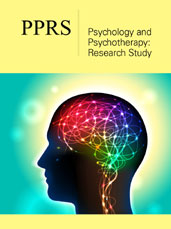- Submissions

Full Text
Psychology and Psychotherapy: Research Studys
Problems of Researching the Personality of People with Hearing Impairments
Bogdanova TG*
Moscow City University, Russia
*Corresponding author: Bogdanova TG, Moscow City University, Russia
Submission: January 09, 2024;Published: June 20, 2024

ISSN 2639-0612Volume8 Issue2
Abstract
The paper is a review of the main approaches to the study of the personality of children with hearing disorders in psychology. The difficulties of studying the personality of these children include the insufficient number of methods that consider the peculiarities of their communication, as well as the problems of adapting methods aimed at studying hearing children and adolescents.
Keywords: Deaf children; Sign language; Communication of the deaf; Projective methods; Questionnaires
Introduction
In recent years, there has been increasing interest in research into the personality of individuals with various developmental disabilities, including children and adolescents with hearing impairments. This reflects both general trends in the development of psychology and specific development trends characteristic of special psychology as one of the rather lateforming branches of psychological science. When studying the personality of children and adolescents with hearing impairments, psychologists face many problems. The main ones are the difficulties of selecting adequate research methods. Some problems are related to the fact that most methods aimed at studying personal characteristics assume a high level of speech development, which children and adolescents with hearing impairment may not achieve [1-5]. Other problems arise from the fact that techniques that are considered reliable when examining individuals with intact hearing produce inconsistent results when studying individuals with hearing loss. Thus, in some studies using the Goodenough-Harris “Draw a Person” test, differences were noted in the drawings of children with hearing impairments (large ears, emphasized mouth) compared to the drawings of hearing people. In other studies, no differences were found in the drawings and doubts were expressed about the possibility of using this technique to study the personal characteristics of children with hearing impairments [2,6].
When using many projective methods, the requirements for speech production are also quite high; most often, subjects are expected to make detailed statements in which the events of a person’s real or internal life should be described. Translation into or from sign speech and its unambiguity when interpreting material obtained using projective techniques have not been sufficiently developed. The interpretation of the results is complicated by the peculiarities of the developmental situation: non-acceptance and even hostility from one’s own family, society, economic and social discrimination lead to the fact that the answers of people with hearing impairments, indicating that they have a feeling of distrust in the world, aggressiveness, etc. - these are special types of adaptation to an “abnormal” environment; this is a healthy, not a psychopathological reaction. An exception is the use of the Wagner hand test to diagnose aggressiveness, which has long been included in the arsenal of psychologists working with adolescents and adults with hearing loss [5].
A big problem is the use of questionnaires - both those designed to study the personality characteristics of hearing people (for example, MMPI, 16 PF, C. Harter’s questionnaire for studying the self-awareness of adolescents, various versions of the unfinished sentence technique), and those developed specifically for people with hearing impairments (there are few of them). In relation to the first group of techniques, questions arise related to the adequacy of adolescents and adults with hearing impairments understanding the meaning of statements and questions. To overcome this shortcoming, it is proposed to use translation into sign language, which leads to difficulties of a different kind: firstly, the problem of the adequacy of the translation arises, increasing the ambiguity of questions and statements (often observed in verbal statements); secondly, the examination situation can traumatize the teenager and even an adult, since a psychologist is most often a hearing person; thirdly, when using an interpreter who speaks sign language, the situation becomes artificial, devoid of ease and the necessary level of trust (an intermediary appears between the teenager and the psychologist, who in some cases can take the initiative in his own hands) [7]. Thus, psychology dealing with the problems of people with hearing impairments, at the present stage of its development, is characterized by a variety of theoretical positions, in accordance with which methodological methods for the psychological study of the personality characteristics of children and adolescents with hearing impairments are developed, methods focused on the population of children and teenagers with intact hearing, attention is paid to the problem of using sign language in the work of a psychologist.
References
- Bat CY (1993) Antecedents of self-esteem in deaf people: A meta-analytical review. Rehabilitation Psychology 38(4): 221-234.
- Cates JA (1991) Comparison of human figure drawings by hearing and hearing-impaired children. Volta Review 93(1): 31-39.
- Lederberg A, Everhart V (2000) Conversations between deaf children and their hearing mothers: Pragmatic and dialogic characteristics. Journal of Deaf Studies and Deaf Education 5(4): 303-322.
- Lederberg A, Golbach T (2002) Parenting stress and social support in hearing mothers of deaf and hearing children: A longitudinal study. Journal of Deaf Studies and Deaf Education 7(4): 331-345.
- Levine ES (1981) The ecology of early deafness, New York, USA, p. 231.
- Marschark M (1993) Psychological development of deaf children. NY Oxford Univesity Press, USA, p. 275.
- Moores DF (1987) Education the deaf: Psychology, principles and practices, Boston, USA, p. 143.
© 2024 Bogdanova TG, This is an open access article distributed under the terms of the Creative Commons Attribution License , which permits unrestricted use, distribution, and build upon your work non-commercially.
 a Creative Commons Attribution 4.0 International License. Based on a work at www.crimsonpublishers.com.
Best viewed in
a Creative Commons Attribution 4.0 International License. Based on a work at www.crimsonpublishers.com.
Best viewed in 







.jpg)






























 Editorial Board Registrations
Editorial Board Registrations Submit your Article
Submit your Article Refer a Friend
Refer a Friend Advertise With Us
Advertise With Us
.jpg)






.jpg)














.bmp)
.jpg)
.png)
.jpg)










.jpg)






.png)

.png)



.png)






